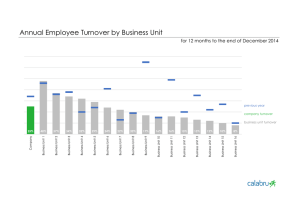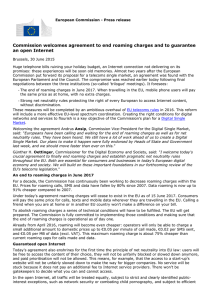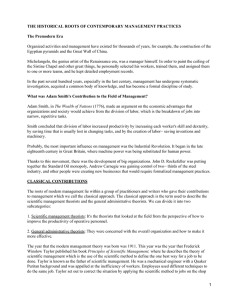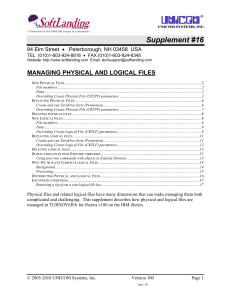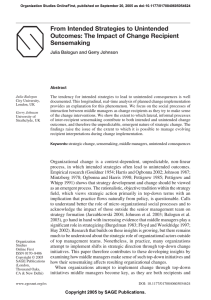Empresa de Telecomunicaciones móviles
Anuncio
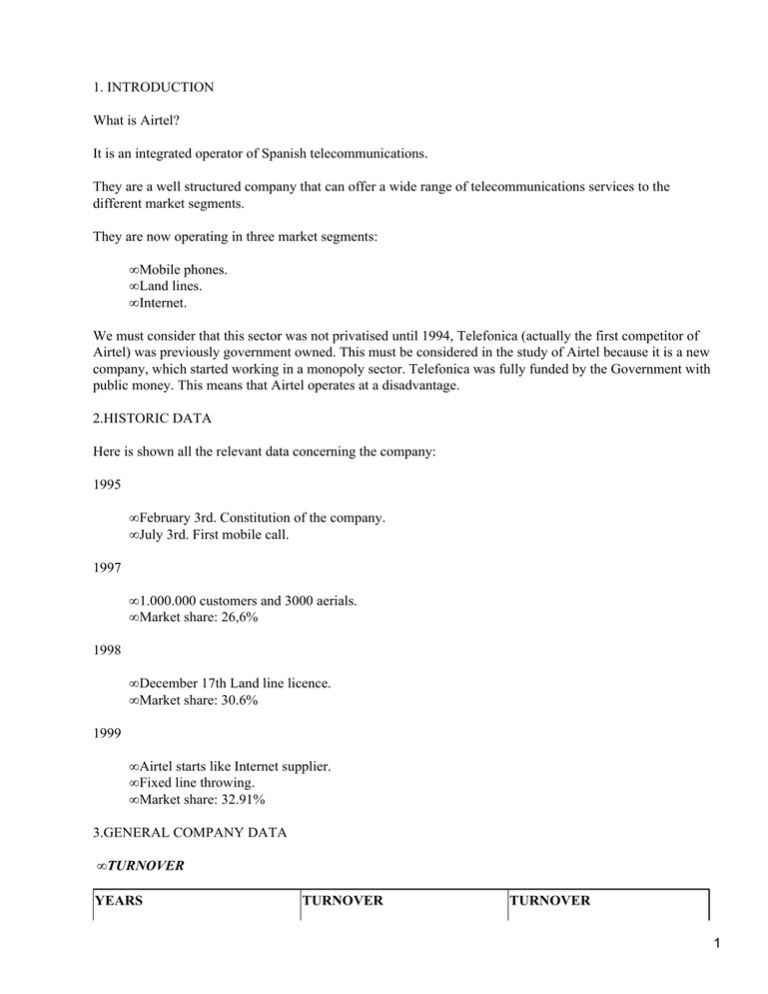
1. INTRODUCTION What is Airtel? It is an integrated operator of Spanish telecommunications. They are a well structured company that can offer a wide range of telecommunications services to the different market segments. They are now operating in three market segments: • Mobile phones. • Land lines. • Internet. We must consider that this sector was not privatised until 1994, Telefonica (actually the first competitor of Airtel) was previously government owned. This must be considered in the study of Airtel because it is a new company, which started working in a monopoly sector. Telefonica was fully funded by the Government with public money. This means that Airtel operates at a disadvantage. 2.HISTORIC DATA Here is shown all the relevant data concerning the company: 1995 • February 3rd. Constitution of the company. • July 3rd. First mobile call. 1997 • 1.000.000 customers and 3000 aerials. • Market share: 26,6% 1998 • December 17th Land line licence. • Market share: 30.6% 1999 • Airtel starts like Internet supplier. • Fixed line throwing. • Market share: 32.91% 3.GENERAL COMPANY DATA • TURNOVER YEARS TURNOVER TURNOVER 1 1995 1996 1997 1998 1999 (M. PTS) 1.011 42.355 112.046 200.000 332.156 (M. POUNDS) 3,74 156,87 414,98 740.74 1230,2 TURNOVER ( M. POUNDS) As you can see the company is in a new market, and the growth in the turnover is important. This means that this is a healthy company. • PROFIT BEFORE TAX: The profits are in million of pounds. 1.995 1.996 1.997 1.998 1.999 0 −194 −79,3 16 139 We can see that in its two years the company has ran at a profit, which is a great achievement. They have recovered all of their costs. c) EMPLOYEES 1.995 1.996 1.997 1.998 1.999 876 1.601 2.320 2968 3.774 • CUSTOMERS (Mobile market): 1.996 1.997 1.998 1.999 2 Airtel 652.000 1.151.000 2.157.000 4.938.000 Market share Airtel. 21.7 % 26.6 % 30.6 % 32.9 % Penetration rate 7.6 % 11 % 17.9 % 37.9 % • CUSTOMERS (In general) 1.995 1.996 1.997 1.998 16.000 652.000 1.151.000 2.157.177 • SHOPS 1.995 1.996 1.997 1.998 1.999 Shops 1.500 6.500 8.800 9.000 10100 • SIGNAL 1.995 1.996 1.997 1.998 1.999 Population (%) 50 % 80 % 95.9 % 97.7 % 98.5 % Land (%) − 35 % 74 % 84.2 % 89.2 % In Airtel the most important market is the expanding mobile market. The signal is considered most important strategical aspect in the mobile market. Airtel has accomplished a great aim and in record time. It has acquired in only three years 98% of the populations signal networks and established more than 5000 signal stations. All of which has been realised without public money. Internationallly they also posses an exceptionally, efficient, and quality signal network. Largely due to the company's state of the art technology and roaming agreements. They have roaming agreements with 57 countries throughout the world. G) SHAREHOLDERS COMPOSITION (In percentage) We can see in the chart that Airtel have two major shareholders, (with nearly half of the capital) BSCH and BT. The structure of the chart illustrates where the managers prime considerations and loyalties will lie. 4. STRUCTURE BY AREAS This company has a divisional structure, but it also has a central authority who control all the divisions. I will describe the structure of the general authority by areas, and the functions of every area. Listed are the divisional areas with the names of the prime managers with responsibility for that area. 3 General secretary: Carlos Lopez • Representation and legal defence. • Coordination of the institutional relationship of Airtel. • Run the administrations Council and the Foundations Secretary. Auditoration and control of management: Puy Bermejo • Verify the company assets and financial situation, and the performance of the company. • Assures the internal fulfilment of the legal norm and procedures. • Reports on the execution of the board of directors goals Industrial cooperation and funds: Jose Luis Ripoll • Guarantee's the fulfilment of the commitments made to the Public Administration, or other social or environmental commitments. (Airtel foundation). Quality management: Miguel Udaondo • To define the quality of the company's systems assuring its, smooth operations. Internet project: Javier Foncillas • To contribute to the added value of the customers mobile. Airtelnet offers access to the Internet by means of an own IP network. Airtel has a vestibule (Navegalia) in which the user finds a multitude of services (chat, e−mail, web). Fixed net Project: Javier Jaquotot • To provide global solutions. To defend and expand the main business of the mobile market, offering two different services of fixed access, or, indirect and direct access. Project department, management and planning information: Jorge Jáudene • Unit responsible for the consolidation company's management information. Operation of institutional and corporative projects. Roaming department, interconnection and regulations: Jorge Dominguez−Sol Diez • Unit responsible for defining the policies of interconnection and roaming departments. Formulating the precise agreements and guarding their fulfilment. Human resources and organisation: Rafael Montes • Management of the total human resources. • To Assure the professional development of the employees and a suitable social climate. Administration and finances: Cesar Arranz • To provide financial and material resources. • To make administrative and accountable support. • To assure the reliability and accountability of financial situations. 4 Information technologies: Pedro Camarero • To develop and to implement informatics systems and corporative communications. To assure technical support, and be constantly available to offer assistance. • To support the development, marketing and the launch of new products and services as required. Net management: Ignacio Camarero • To plan, to develop, to operate, to maintain and to optimise the network of the company. • To provide a GSM communication of high quality. Sales management and commercial framework: Francisco de Alvaro Markets and customers: Enric Martín • To attract new customers. By improving the management of the distribution and channel networks. • Management of customer services and of customer claim processes. • To maximise the introduction and use of the company's products and services. 5. TERRITORIAL STRUCTURE The company divides Spain into eight divisions, which work independently. • Division 1: Central • Division 2: Cataluña and Aragon. • Division 3: Levante and Baleares. • Division 4: North. • Division 5: South. • Division 6: northwest. • Division 7: Canarias Islands. • Division 9: Castilla and Leon. 5 Each company division different numbers of workers, shops, etc. It depends on variables like the following ones: • Habitants per division. • Important towns. • The position of the competitors. • Strategic position. 6. DIVISIONS STRUCTURE, AND FUCTIONS The business works in divisions. Each division is independent from the rest and shows the results to the top management. A division is made of: • The division's manager: Who's the one that answers for the results of the division, and is the one who has to comment or bring to light the problems within his division, so that the decision makers take the appropriate measures. He has freedom of movement and flexible time. Normally they are located in the city where the main operations of the division take place. He is connected to a mobile phone, land line, internet and has a couple of assistant managers to coordinate movements. He has the obligation to visit all the posts within the division for, at least, twice a year. He asks the workers what's going well, what's going bad and how can things be improved. • Key Account Manager: (no more than 5 per division). They are in charge of the key accounts (societies, public and limited companies). 6 They have the obligation of visiting their clients at least twice at month. To motivate them, they have a fixed wage and a bonus for each new account or client they achieve. They communicate by land and mobile telephone line and through an intranet called Airnet which is only for the employees. He work alone and he will mostly have a couple of sales people to help him at his office. He must send all the orders, and contracts of the clients, to the city where the division is centred. and the central of the division send him by post the telephones, accessories and remaining details. • Sales people: They work in shops strategically located in each city of the division. Depending upon the number of shops and the importance of the city there where more, or less, sales people. They work with everyday customers, and are prohibited to compete with the other ones; in other words, they can make contracts with business. • Technicians: They are in charge of maintenance of the aerials and of the signal. • Programming service: They are in charge of the problems and decisions that have to made within the division; with respect to programming and computer science. They obey the orders of the programming department. They have the obligation to visit each worker twice a year, to know of any problems or possible improvements. • For the remaining functions: Such as, cleaning, transport, post etc the business subcontract those services. 7. FORMAL AND INFORMAL COMUNICATIONS AND MY OPINIÓN. As a general rule, each member within the division meets informally with the members of the some position within the business. I consider that there is a bad relation within the posts at different levels because there isn't much need for it and the workers of different levels don't collaborate with each other. Each worker has to write into the intranet their daily work, which is read at the central of the company in Madrid. At the end of each month Madrid sends the results to each division, and the main manager sends to each worker to the e−mail. We have to highlight that the employees meet twice a year at the central city of each division, to comment of any problems and solutions, to receive information of new ways of action, and possible changes within the company's politics. In my opinion, this business has the necessary bureaucracy and it is well distributed. It has managed to create competition within the workers, but this is a double weapon, due to, in one side has a motivation, but on the other that competition makes them hide the information, which could benefit their team members. This makes a more conflictive relation, and each worker only performs their soul duty, because a lot of them think, that they could have their clients stolen from them. We must highlight, that within their communication, which depends upon the problem, bureaucracy could disappear and could present the problem in Madrid in five minutes. 7 The one criticism one can make is that one can make is that the business is very centralized, each worker, who is the one that really knows the client and knows their problems, has a very little decision power. Or what is the same very little response capacity. But the solution isn't easy to take, because if you want the control, the sellers have less decision power. If you want the decision power to the seller, you can't control all. But is one of the most important decision that the company must take. 8. BIBLIOGRAPHY − Organisation and administration theory (Brown and Moberg) − Company management (Jane Aubert−krier) − Personal administration (Paul Pigors and Charles A. Mayers) − Internet − Workers of the company. − My experience inside of the company 6 11 8 9
